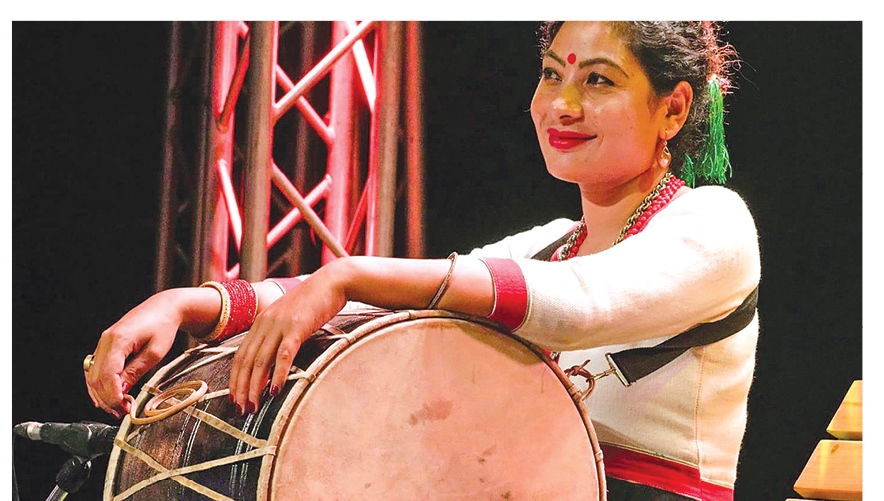The Dhimay Girl

By Mannu Shahi
For as long as there has been music in Nepali society, there have been three kinds of musicians – the musicians who play cultural, ritualistic musical instruments as part of their social duty, the court performers who play before the aristocrats and the royals and the “modern” artists who plays the “new” tunes, semi-classical or folk, who records his work and releases it for fame, fortune and appreciation. Indira Lachhimasyu is a blend of the first and the last category.
Better known as the Dhimay Girl, she plays the cultural instrument ‘Dhimay’ because she feels it is her duty, her calling and her purpose. But by doing so, she has been able to break into the mainstream and get famous in a way that most traditional musicians sadly are not usually able to.
Her journey with Dhimay started at the age of 12, when her father saw her nodding to the melody of the instrument. A Dhimay instructor, her dad was impressed by her ability to catch the patterns and decided to teach his daughter to play the Newa drums. This sounds casual but this was a big step for the time.
We have to remember that until a few decades ago, girls were not even allowed to touch the instrument, let alone play. There were a lot of gender-based restrictions on musicians and Indira and her father faced a lot of pressure and backlash. However, they did not give in.
Strong-willed Indira kept pushing through the criticism and her critics and continued to hone her skills and talent. In the process, she met world-renowned ethnomusicologist Dr. Gert M. Wegner, former head of the Department of Music at Kathmandu University. Convinced of her abilities, Wegner invited Indira to join his musical ensemble called The Master Drummers of Nepal and with them, she toured Italy, Germany, the Czech Republic, Austria, France and other regions of Western Europe.
Her involvement with the band boosted her confidence and showed everyone that, contrary to popular belief, female musicians could have a career in this field. Following her tour, Indira collaborated with many other artists and later, formed her own percussion-led ensemble titled The Dhimay Girls.
As a member of this band, Indira also started teaching different Newa drums to students in co-ed schools and aspiring women percussionists.
And, after years of struggle and countless ups-and-downs, today, Indira stands as one of the respected figures in folk music in Bhaktapur. She performs with her students frequently at the Dattatreya Temple square and also plays in concerts, does session percussion works and advocates for gender equality through her work.
She has also started a YouTube channel through which she provides music lessons. Indira is also married with two kids.
So the next time you pass by a Newa musical procession, keep an eye out for any female Dhimay players and if you see one, remember Indira who took on the society with her father and paved the way for women to enter this field. And show her your gratitude by subscribing to her channel and sharing her uploads.
Recent News

Do not make expressions casting dout on election: EC
14 Apr, 2022
CM Bhatta says may New Year 2079 BS inspire positive thinking
14 Apr, 2022
Three new cases, 44 recoveries in 24 hours
14 Apr, 2022
689 climbers of 84 teams so far acquire permits for climbing various peaks this spring season
14 Apr, 2022
How the rising cost of living crisis is impacting Nepal
14 Apr, 2022
US military confirms an interstellar meteor collided with Earth
14 Apr, 2022
Valneva Covid vaccine approved for use in UK
14 Apr, 2022
Chair Prachanda highlights need of unity among Maoist, Communist forces
14 Apr, 2022
Ranbir Kapoor and Alia Bhatt: Bollywood toasts star couple on wedding
14 Apr, 2022
President Bhandari confers decorations (Photo Feature)
14 Apr, 2022











